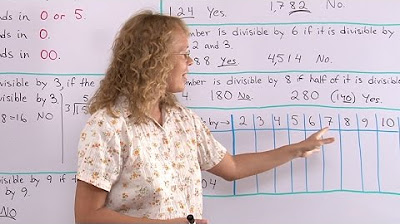This completely changed the way I see numbers | Modular Arithmetic Visually Explained
TLDRThis video explores fascinating number theory concepts, such as the properties of prime numbers and divisibility rules, using a visual 'wheel math' approach. It demonstrates how to quickly determine if a number is prime by checking divisors less than its square root and explains modular arithmetic through a seven-spoked wheel. The video also touches on the application of these mathematical principles in cryptography, showcasing the Diffie-Hellman protocol for secure communication. Viewers are encouraged to delve deeper into number theory through Brilliant's interactive courses.
Takeaways
- 🔢 The video introduces number theory concepts with a focus on prime numbers and their properties.
- 📊 It demonstrates how to determine if a number is prime by checking for divisors less than its square root.
- 🔑 The script explains the use of modular arithmetic, or 'wheel math,' for visualizing remainders and divisibility.
- 📐 It shows how to use the properties of exponents and prime numbers to quickly solve divisibility problems.
- 🎲 The video uses a wheel with a prime number of sections to illustrate Fermat's Little Theorem and other divisibility rules.
- 📈 The concept of digital roots and their application in determining divisibility by 9 is explained.
- 🔐 The script touches on the basics of cryptography, mentioning the diffie-hellman protocol for establishing a secret key.
- 🎯 It highlights the importance of prime numbers in cryptography for secure communication.
- 📚 The video encourages viewers to explore further with Brilliant's number theory course for a deeper understanding.
- 🎁 The sponsor, Brilliant, offers a 20% discount for the annual premium subscription to their platform.
- 📘 The video concludes with a call to action for viewers to like, subscribe, and follow the channel for more content.
Q & A
What is the main topic discussed in the video?
-The main topic of the video is number theory, with a focus on various mathematical properties and theorems related to prime numbers, divisibility, and modular arithmetic.
Outlines
🔢 Sponsored by Brilliant: Exploring Number Theory
The video is sponsored by Brilliant, introducing intriguing number theory problems. Examples include raising an integer to the 5th power to observe its ones digit, and analyzing prime numbers squared and their divisibility by 24. The speaker discusses the basics of number theory, demonstrating how to determine if a number like 119 is prime by checking divisors up to its square root. The concept of representing composite numbers using primes is explained, emphasizing their unique factorization.
🧮 Wheel Math and Modular Arithmetic
The concept of modular arithmetic, referred to as 'wheel math', is introduced. A visual representation using a wheel with seven sections illustrates how numbers and their remainders work when divided by seven. The method simplifies addition, multiplication, and exponentiation within this system. The speaker explains that numbers in the same section have congruent remainders, and any number raised to the 6th power on this wheel will have a remainder of one, showcasing Fermat's Little Theorem.
🔢 Patterns in Prime Numbers and Divisibility
The video explores the properties of numbers, including how raising any number to the fifth power retains its ones digit. Using a wheel with twelve sections, the relationship between prime numbers and their positions is examined. The speaker explains why prime numbers squared minus one are divisible by 24, using the properties of even and odd numbers. The concept of digital roots is introduced, showing how they can determine divisibility by 9 and 3, and their interesting behavior in the Fibonacci sequence.
🔐 Basics of Cryptography and Secure Communication
The video shifts to cryptography, demonstrating how modular arithmetic can establish secure communication. Using the Diffie-Hellman key exchange protocol, the speaker explains how two parties can create a shared secret key, even with an eavesdropper listening. The method involves selecting a base value and secret numbers, then performing calculations on a wheel with a prime number of sections. This concept underpins modern cryptographic methods, ensuring secure message encryption.
📚 Brilliant's Courses and Learning Opportunities
The speaker highlights Brilliant's extensive course offerings, including number theory, differential equations, complex analysis, and more. Interactive exercises and practical applications are emphasized to deepen understanding. The platform also provides daily challenges to encourage consistent learning. Viewers are encouraged to sign up for Brilliant to support the channel and gain access to these educational resources.
Mindmap
Keywords
💡Prime Number
💡Divisibility
💡Modular Arithmetic
💡Square Root
💡Factorial
💡Cryptography
💡Fermat's Little Theorem
💡Digital Root
💡Divisibility Rule
💡Diffie-Hellman Protocol
Highlights
Sponsored video by Brilliant exploring number theory and its applications.
Raising any integer to the 5th power retains the same ones digit.
Squaring any prime number greater than 3 and subtracting one results in a number divisible by 24.
Introduction to the basics of number theory in a visual format.
Explanation of how to determine if a number is prime by checking divisors.
Prime numbers are the building blocks of all other numbers.
Composite numbers have a unique prime factorization.
18 factorial is not divisible by 23 due to prime factor composition.
The theorem that a composite number's prime factors must be less than its square root.
Demonstration of using the square root theorem to check for compositeness.
Introduction to 'wheel math' or modular arithmetic for visual problem-solving.
Wheel math demonstrates remainders and divisibility through a spiral pattern.
Properties of numbers on a wheel with a prime number of spokes, like 7.
Application of wheel math to quickly determine divisibility and remainders.
Fermat's Little Theorem explained through the wheel math concept.
Digital root concept and its application to divisibility by 9.
The connection between digital roots and the Fibonacci sequence.
Cryptography application using the diffie-hellman protocol as an example.
Brilliant.org's number theory course and its comprehensive learning approach.
Invitation to subscribe and support the channel for more educational content.
Transcripts
5.0 / 5 (0 votes)
Thanks for rating:





